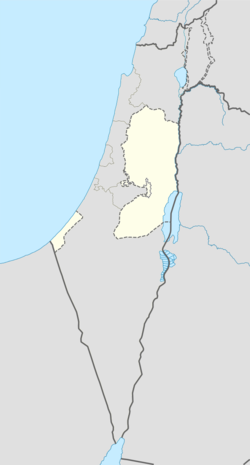History
Ottoman Era
In the 1596 tax records, Beit Sira was a part of the nahiya ("subdistrict") of Ramla, part of Gaza Sanjak, in the Ottoman Empire, with a population of 17 Muslim household. The villagers paid a fixed tax-rate of 25% on agricultural products, including wheat, barley, summer crops, vineyards, fruit trees, goats and beehives, in addition to occasional revenues; a total of 4,500 akçe. All of the revenue went to a Waqf. [6]
In 1838, it was noted as a Muslim village in the Ibn Humar District, part of the er-Ramleh area. [7]
In 1863 Victor Guérin noted Beit Sira as a considerable village on the summit of a rocky hill. A saint, revered under the name of Neby Sira, had a sanctuary there with his tomb. [8] Socin, citing an official Ottoman village list compiled around 1870, noted that Bet Sira had 39 houses and a population of 125, though the population count included only men. [9] Hartmann found that Bet Sira had 29 houses. [10]
In 1873, Clermont-Ganneau was told that Beit Sira supposedly housed the tomb of Neby Sira, a son of Jacob and brother to Neby Ma'in (possibly Benjamin), the founder of Bir Ma'in. [11]
In 1883, the PEF's Survey of Western Palestine (SWP) described it: "A small village on a swell in the low hills. A main road passes through it. The water supply is artificial." [12]
British Mandate era
In the 1922 census of Palestine conducted by the British Mandate authorities, Beit Sira had a population of 381 Muslims, [13] increasing in the 1931 census to 460 Muslims in 113 houses. [14]
In the 1945 statistics the population was 540, all Muslims, [15] while the total land area was 4,687 dunams, according to an official land and population survey. [16] Of this, 205 dunams were plantations and irrigable land, 1,924 for cereals, [17] while 23 dunams were classified as built-up (urban) areas. [18]
Israeli occupation
Since the Six-Day War in 1967, Beit Sira has been under Israeli occupation.
After the 1995 accords, 9.3% of Beit Sira land was classified as Area B, the remaining 90.7% as Area C. [20] In 2012, approximately 78% of the village population worked in the Israel labor market. [21] Israel has confiscated 1,499 dunams of land from Beit Sira for the construction of the Israeli settlement of Maccabim, presently part of Modi'in-Maccabim-Re'ut. [22]
According to the Palestinian Central Bureau of Statistics, Beit Sira had a population of 2,840 inhabitants in 2006. [23] In the 2007 PCBS census, there were 2,749 people living in the town. [24] By 2017, the population was 3,343. [1]
This page is based on this
Wikipedia article Text is available under the
CC BY-SA 4.0 license; additional terms may apply.
Images, videos and audio are available under their respective licenses.




